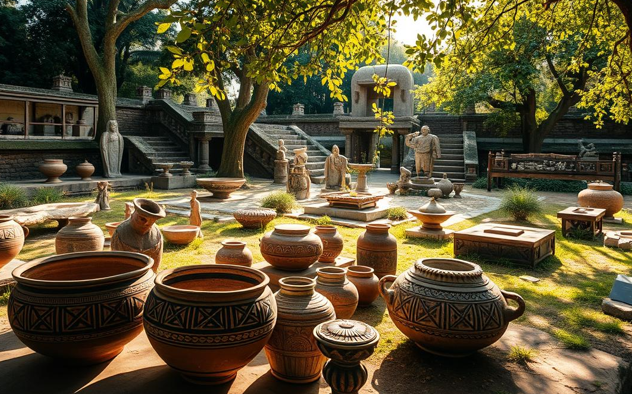Introduction to the beauty and timelessness of ancient artz
Ancient Artz has always been a reflection of humanity’s soul. It transcends time, connecting generations through shared emotions and experiences. Ancient art forms sparkle with timeless beauty and endless inspiration, revealing the creativity of our ancestors who had profound stories to tell. From intricate cave paintings to delicate sculptures, these artistic expressions have shaped cultures and continue to resonate today.
In this exploration of ancient artz, we’ll uncover eight legendary forms that not only capture the imagination but also remind us of our roots. These vibrant creations offer a glimpse into civilizations long past while igniting sparks of creativity within us now. Let’s embark on this journey through history where every brushstroke, chisel mark, and crafted fold whispers tales from ages gone by!
Cave Paintings: The Start of Artistic Expression
Cave paintings represent humanity’s earliest attempt at artistic expression. Found in locations like Lascaux and Altamira, these stunning works date back tens of thousands of years.
The vibrant colors and intricate designs depict animals, human figures, and abstract shapes. They offer a glimpse into the thoughts and beliefs of prehistoric societies.
These ancient artists used natural pigments from minerals and charcoal to create their masterpieces. Their techniques were remarkably advanced for the time, showcasing creativity that transcends generations.
Cave art was more than mere decoration; it served as a narrative tool. It communicated stories about hunting rituals or significant events within their communities.
Today’s artists still draw inspiration from these profound expressions of our ancestors. The allure of cave paintings lies not only in their beauty but also in their ability to connect us across millennia through shared experiences.
Egyptian Hieroglyphics: A Window into Ancient Culture
Egyptian hieroglyphics are more than just symbols; they form an intricate tapestry of ancient life. Each character tells a story, revealing insights into religion, governance, and daily activities.
These symbols were not merely for decoration. They served as a vital communication tool that connected people across generations. From temple walls to the tombs of pharaohs, hieroglyphics conveyed messages meant to last beyond death.
The artistry involved in their creation is mesmerizing. Scribes dedicated their lives to mastering this complex writing system. The combination of logographic and alphabetic elements created layers of meaning that continue to fascinate scholars today.
Through these carvings and inscriptions, we glimpse the values and beliefs held by ancient Egyptians. Their reverence for the afterlife is evident in every carved word—a reminder that culture transcends time through artful expression.
8 Legendary Ancient Art Forms That Still Inspire
Ancient Art is a timeless expression of human creativity. The legacy of ancient art forms continues to influence contemporary artists worldwide.
Cave paintings draw us back to our primal roots. They speak volumes about early human life and storytelling.
Egyptian hieroglyphics mesmerize with their intricate symbols. Each character holds stories that illuminate the past, bridging cultures across millennia.
Greek sculptures showcase an unparalleled mastery of form. These masterpieces reflect ideal beauty and emotion, inspiring countless generations.
Chinese calligraphy transforms writing into visual poetry. Each stroke embodies elegance and discipline, celebrating the written word as an art form itself.
Indian mehendi enchants with its intricate designs on skin. This body art tells tales through patterns passed down through generations.
Japanese origami captivates with its delicate paper folds, turning simple sheets into breathtaking creations that evoke wonder.
Mayan architecture stands as a testament to ingenuity. Its grand structures reveal deep connections between culture, spirituality, and artistry within society’s fabric.
Greek Sculptures: Capturing the Human Form in Perfection
Greek sculptures are a celebration of the human form. Artists like Phidias and Praxiteles mastered techniques that brought figures to life, showcasing beauty and realism.
These works often depicted gods, athletes, and everyday people. Marble was meticulously carved to highlight intricacies such as muscle definition and facial expressions. The use of contrapposto—a stance where weight is shifted onto one leg—added dynamic movement to their creations.
Each piece tells a story, conveying ideals of strength, grace, and heroism. The craftsmanship involved reflects not just skill but an understanding of anatomy that still captivates artists today.
In museums worldwide, Greek sculptures continue to inspire modern artistry. Their timeless elegance serves as a reminder of humanity’s enduring quest for perfection in art. Visitors often find themselves lost in the gaze of these ancient figures, feeling an unbreakable connection across centuries.
Chinese Calligraphy: The Art of Writing as an Art Form
Chinese calligraphy transcends mere writing; it embodies a profound artistic expression. Each stroke tells a story, reflecting the emotions of the artist.
The brush dances gracefully across rice paper, transforming simple characters into intricate masterpieces. The balance between form and fluidity is crucial. It requires years of practice to master.
Traditionally, ink made from soot mixed with water served as the medium. The choice of brush influences texture and depth, adding character to each piece.
Every work captures harmony—a blend of technique and emotion that resonates through centuries. Calligraphy isn’t just about letters; it’s about conveying meaning and beauty simultaneously.
In modern times, this ancient art continues to inspire countless artists worldwide. Workshops proliferate in cities globally, bridging cultures through this timeless form of expression.
Indian Mehendi: A Traditional Form of Body Art
Indian Mehendi, also known as henna, is a mesmerizing form of body art steeped in tradition. This intricate artistry finds its roots in ancient India and has been cherished for centuries.
Typically applied during festivals, weddings, and special occasions, mehendi transforms the skin into a canvas. The rich brown stain it leaves behind can last several days. Each design carries symbolic meanings ranging from love to prosperity.
Artisans skillfully create elaborate patterns featuring flowers, peacocks, and geometric shapes. The process itself is both meditative and joyful as friends gather to share stories while they adorn their hands.
Using natural ingredients makes mehendi not only beautiful but safe for the skin. It’s more than just decoration; it’s an expression of cultural identity that connects generations through its vibrant history and artistic legacy.
Japanese Origami: The Delicate Craft of Paper Folding
Japanese origami is a mesmerizing art form that transforms simple sheets of paper into intricate designs. With roots tracing back to the 17th century, it showcases both creativity and precision.
At its core, origami embodies patience and skill. The delicate folds can create anything from majestic cranes to blooming flowers. Each piece tells a story of dedication and finesse.
What sets origami apart is its blend of tradition and modernity. Artists today continue to push boundaries, experimenting with complex techniques and unique materials. This evolution keeps the craft alive in contemporary culture.
Moreover, each fold carries significance. For instance, the crane symbolizes peace and hope—a powerful message wrapped in beauty. As you engage with this timeless practice, you not only appreciate aesthetic appeal but also connect with centuries-old wisdom embedded within each creation.
Mayan Architecture
Mayan architecture stands as a testament to the ingenuity of an ancient civilization. With its impressive pyramids, palaces, and temples, it reflects both functionality and spiritual significance.
The use of limestone was prominent. The Mayans expertly carved intricate designs into stone, telling stories that have lasted through centuries. Structures like El Castillo in Chichen Itza display remarkable astronomical alignments.
Communities built their cities in harmony with nature. Each site was strategically placed to honor celestial events or local geography. This deep connection is evident in every archway and plaza.
Mayan structures often served multiple purposes—religious ceremonies took place alongside daily activities. The fusion of the sacred and mundane creates layers of meaning within each architectural feat.
Today, these ruins continue to inspire architects and historians alike, captivating those who wander through their remnants.
Conclusion
Ancient art forms are not just relics of the past; they continue to shape our contemporary world. The influence of these artistic expressions can be seen in various modern mediums, from digital artwork to fashion design.
As we explore the depths of human creativity through history, we find that ancient techniques often inspire revival and innovation today. Artists draw on traditional methods while blending them with new ideas.
The legacy of ancient arts also emphasizes cultural identity. Each form tells a unique story about its origin, reflecting societal values and beliefs.
In every brushstroke or chisel mark lies an invitation for us to connect with generations long gone. Their visions resonate within us, leading to endless exploration and appreciation of beauty across time.
Embracing these art forms enriches our lives and deepens our understanding of humanity’s shared journey.
Frequently Asked Questions (FAQs)
The fascinating world of ancient artz continues to captivate and inspire generations. These timeless expressions of creativity reveal the profound connection between humanity and artistic endeavor. Visitors still marvel at cave paintings, Egyptian hieroglyphics, Greek sculptures, and more. Each form tells a story that transcends time.
Frequently Asked Questions (FAQs)
What is Ancient Artz?
Ancient Artz refers to various forms of art created by early civilizations, showcasing their cultures, beliefs, and daily lives through mediums like painting, sculpture, writing, and architecture.
Why is ancient artz important today?
Ancient artz serves as a window into the past. It helps us understand historical contexts while influencing modern artists who draw inspiration from these age-old techniques and styles.
How did cave paintings originate?
Cave paintings date back over 30,000 years ago. Early humans used natural pigments to create images on cave walls as a form of expression or communication about their surroundings.
What can we learn from Egyptian Hieroglyphics?
Egyptian hieroglyphics provide insights into the culture’s religion, politics, and everyday life. They demonstrate how language evolved alongside visual arts in shaping civilization’s narrative.
Are there modern adaptations of ancient artz forms?
Absolutely! Many contemporary artists incorporate elements from ancient styles—like Indian Mehendi or Japanese origami—into current works while adding personal touches.
Is it possible to experience these ancient artz forms today?
Yes! Museums worldwide showcase replicas or original pieces of ancient artworks. Additionally, workshops are available for those interested in learning traditional methods like calligraphy or origami folding.
Explore your own creative journey inspired by these legendary forms that have stood the test of time.

